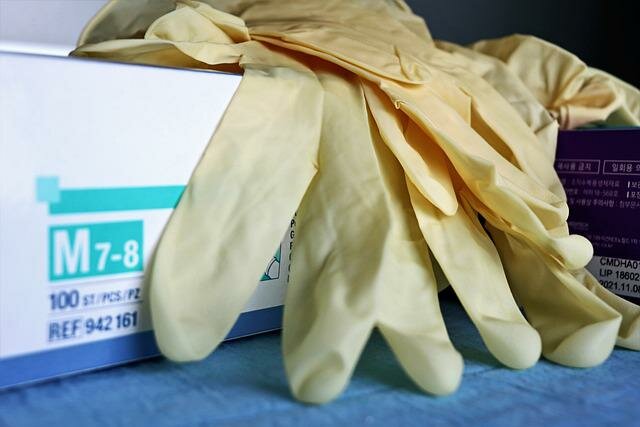What is a latex allergy?
Natural latex is found in a wide variety of objects, such as balloons, work gloves (for cleaning and medicine), door seals and condoms. In the case of a latex allergy, the immune system reacts allergically to certain substances contained in natural latex. There are two different types of allergy:
- In the case of a contact allergy, the additives in latex products trigger allergic reactions, such as hives in the areas of the skin that have come into contact with latex (contact eczema).
- In the case of an immediate allergy, the body reacts to the water-soluble proteins contained in natural latex.
Typical symptoms of a latex allergy are, as with pollen or animal hair allergy, reddening of the skin, papules, irritation of the eyes and respiratory tract and can, in the worst case, lead to allergic shock.
How common is latex allergy?
The German Allergy and Asthma Association (Deutscher Allergie- und Asthmabund e.V.) speaks of two percent of the total population being affected by latex allergy. Among employees in the medical sector (e.g. hospitals, nursing homes), this percentage is even between ten and 17 percent. Allergic reactions to latex are therefore far from rare.
Who is particularly at risk?
- Workers in the medical sector
- Employees in the rubber processing industry
- People with atopic dermatitis
- Children who often need early surgery, e.g. children with spina bifida or congenital malformations of the urinary tract.
Cross-allergies in people with latex allergies
Hypersensitivity reactions to certain exotic fruits and/or vegetables can also be a sign of a latex allergy. Be careful with:
Foods:
- Acerola cherry
- Pineapple
- Avocado
- Banana
- Chestnut
- Potato
- Kiwi
- Mango
- Maracuja
- Papaya
- Peach
- Celery
Plants can also trigger allergic symptoms. People allergic to latex should avoid the following plants:
- Ficus benjamina (prickly pear)
- rubber tree
- Cactus
- Oleander
- Poinsettia
Advice for people with latex allergies
- Replace latex products with synthetic rubber materials
- In case of cross-allergies, avoid named foods and plants
- Always carry your allergy passport with you
- In case of medical intervention or hospitalization, inform the doctors and staff of your allergy.
- Carry an emergency kit with you, so that you can treat latex allergy symptoms that appear suddenly, even if medical help is not immediately available.
If you regularly come into contact with natural latex in the course of your work, your doctor should report this to the relevant professional association. The association must then determine whether contact with the allergen can be avoided by special protective measures. If this is not possible, a change of occupation may be necessary in particularly severe cases.
Typical symptoms of a latex allergy
A latex allergy usually manifests itself as an allergic skin reaction which may spread to other parts of the body or be accompanied by swelling of the eyelids. As with other allergies, disorders of the digestive system or respiratory tract may also result. An asthma attack can occur several hours after contact with latex. In particularly severe cases, latex allergy can also lead to anaphylactic shock.
Overview of possible symptoms
- redness of the skin
- Formation of papules, including spread to other parts of the body
- Swelling of the eyelids
- Itching
- Swelling of the mucous membranes of the eyes and nose
- Tearing of the eyes
- nasal discharge
- Gastrointestinal disorders
- Throat and pharynx disorders
- Difficulty breathing
Swelling of the lips during ballooning or hypersensitivity reactions to certain exotic fruits such as avocados, bananas, kiwis, mangoes, maracujas (passion fruit) or papayas may also be signs of a latex allergy.
Treatment of a latex allergy
Acute symptoms can be treated with anti-allergy drugs or cortisone preparations. In the case of allergic bronchial asthma, inhalations with substances such as salbutamol may also be considered.
In addition, people should try to avoid contact with the allergenic agent. Allergenic immunotherapy – also known as hyposensitisation – as practised today with good results for other allergies such as pollen or dust mite allergies, is unfortunately not yet an option for latex allergy.
How is a latex allergy diagnosed?
In order to determine whether it is a latex allergy, the doctor usually starts by asking in detail what disorders have occurred, when and under what circumstances. In addition, known allergies can also play an important role in the diagnosis.
Allergy tests :
- Blood test: Blood is analysed for the presence of IgE antibodies specific to natural latex.
- Prick test: A solution containing latex allergens is brought into contact with immune cells in the skin to see if they trigger an allergic reaction in the person concerned.

